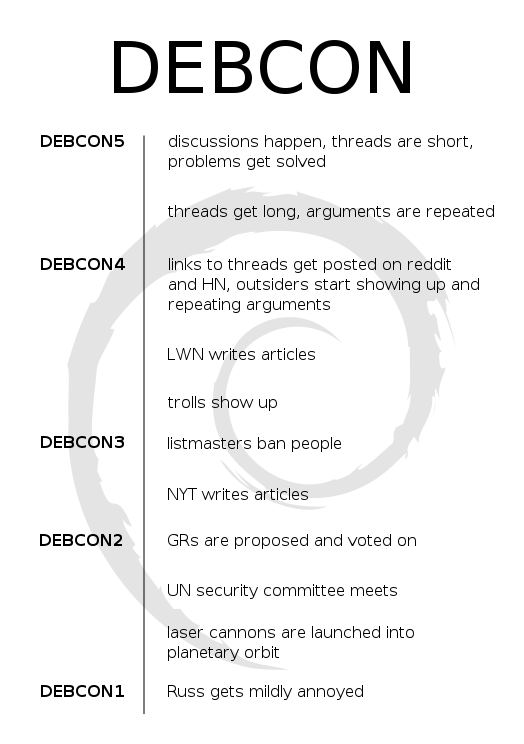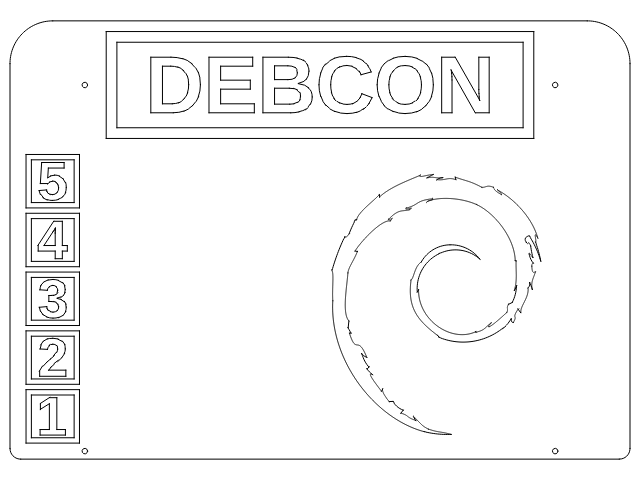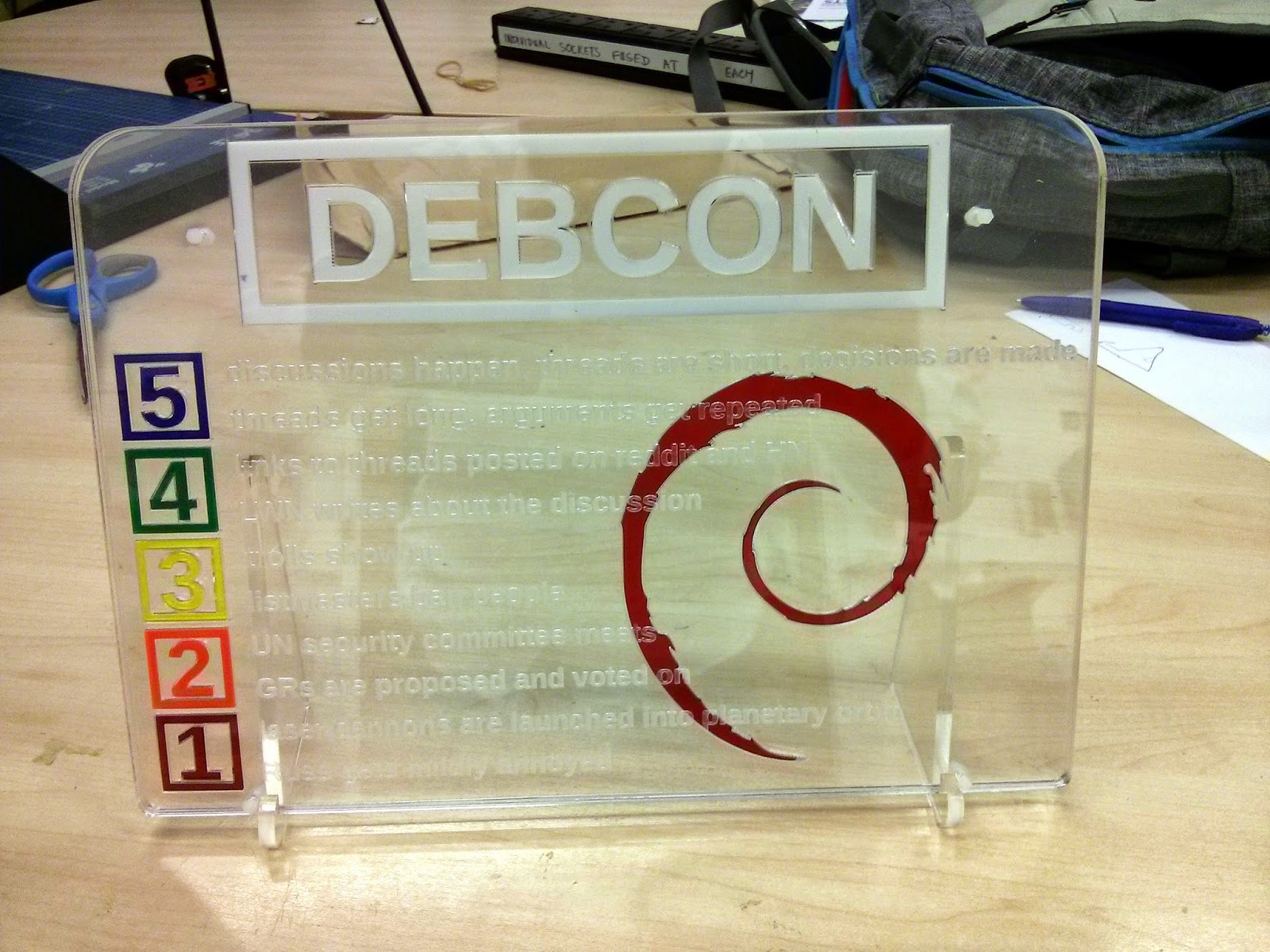
Meet Alfred. Alfred is a Debian user. He has a laptop with Debian and
a desktop environment running on it. Alfred does a lot of impotant
things on his computer: his hobby is to photograph his cat, and also
he works for a non-governmental organisation that investigates and
reports on human rights violations. His job involves a lot of travel
to many parts of the world, and he needs to handle a lot of very
sensitive information. His laptop uses full-disk encryption, and it's
generally speaking very well secured against the various security
threats that are due to his job.
He is worried about losing important data. He's not too worried that
the sensitive information he has will leak if his laptop is stolen,
but it might be impossible to re-create the data if the laptop is
gone. If he interviews a whistleblower for a slave-trading
corporation, and his laptop is stolen after that, it might be
impossible to ever meet with the whistleblower again.
Alfred wants backups of his data. He gets a USB thumb drive, and
plugs it in. The laptop has never seen the drive before, so it asks
Alfred if the drive should be used for backups. Alfred says yes.
The laptop formats the thumb drive, again with full-disk encryption,
and then runs a backup. The backup automatically picks up all the
files from Alfred's home directory, and some system confguration files
that may be necessary as well. (Read: /home and /etc.) Files that are
usually not very precious, such as web browser caches, are
automatically excluded.
Later, when Alfred wants to update the backup, he plugs in the same
drive again. The system recognises the drive, and runs the backup.
While the backup is running, Alfred has an indicator in his desktop
status bar. If Alfred leaves the drive plugged in, and changes
anything in his home directory, that gets immediately backed up to the
backup drive. Until the changes have been backed up, the indicator
stays on Alfred's status bar.
This isn't good enough, however. Alfred needs to carry the USB drive
with him, and if he's mugged, he might lose both the laptop and the
backup drive. Therefore, the system administrator at Alfred's NGO,
Janet, sets up an account on an online backup server, and e-mails
Alfred a configuration file, which Alfred drops into the backup
system's configuration tool.
From then on, whenever Alfred's laptop is online, and can see the
backup server (identified by an SSH host key), any changes Alfred
makes are backed up as soon as possible. For the next interview, as
soon as the interview is finished and Alfred closes the laptop lid to
suspend it, the backup has already finished, both to the online server
and the USB thumb drive.
Alfred is now happy, and no longer fears for the safety of his data.
Janet, however, is still a little worried, because the online backup
server is an attractive target for attacks. She asks Alfred to
configure the backup service on the laptop to encrypt and digitally
sign the backups, and sends the master backup public key with the
request. Janet keeps the corresponding private key in a secure
location.
Alfred goes into the configuration dialog, ticks the right box, and
drops in the server public key. The backup software generates a new
public key for the laptop to use for encrypting the backups, and
Alfred e-mails that to Janet, using PGP encrypted and signed e-mail.
He also puts the laptop backup encryption keys on a couple of USB
thumb drives, which he stores in safe places (in his sock drawer and
coffee jar, but don't tell anyone that).
Alfred's online backups are now encrypted with public keys so that
both Alfred and Janet can decrypt them, but only they can do that. The
backups are digitally signed so that if the server is hacked, the
backups can't be altered without it being detectable.
Some time passes.
Alfred needs to go to speak to the general assembly of the Cat
Conference, about how awesome his cat is. This requires him to travel
to the US, and he's worried that the US authorities will confiscate
his laptop and try to get at his work files that way. He deletes all
his work files, ssh keys, and other files that aren't necessary to
show his cat pictures at the conference.
The conference goes fine, and when Alfred comes back home, he gets the
USB thumb drive that contains his backup encryption key. He plugs it
in, tells the backup configuration software to import it. Alfred can
then open his backups on the online backup server in his file browser,
and can restore back his files by copying them with drag and drop.
However, the next day Alfred's cat, upset at how much he travels, pees
on the laptop. It is ruined. Everything is lost.
Alfred gets a new laptop from Janet, and installs Debian on it. During
installation, Alfred gives the installer the USB backup drive, and the
installer restores all of Alfred's own files, and also restores system
configuration. After a little while, Alfred has a newly installed
laptop with all his usual software and all of his files.
This is a summary of a vision for backups being a service in a default
Debian install in the future. It is currently just a vision, and
nobody is currently working on making it reality. Would you like to
work on this for the release after jessie?
(No cats were harmed in the production of this vision.)
 I have just released version 1.10 of Obnam, my backup program. See the
website at http://obnam.org for details on what it does. The new
version is available from git (see http://git.liw.fi) and as Debian
packages from http://code.liw.fi/debian, and uploaded to Debian,
hopefully soon in unstable.
The NEWS file extract below gives the highlights of what's new in this
version.
Version 1.10, released 2015-07-01
Major bug fixes:
I have just released version 1.10 of Obnam, my backup program. See the
website at http://obnam.org for details on what it does. The new
version is available from git (see http://git.liw.fi) and as Debian
packages from http://code.liw.fi/debian, and uploaded to Debian,
hopefully soon in unstable.
The NEWS file extract below gives the highlights of what's new in this
version.
Version 1.10, released 2015-07-01
Major bug fixes:
 Call for Proposals Deadline
The deadline for submitting proposals is approaching, with only 12 days left to submit your event by June 15th. Events submitted after that date might not be part of the official DebConf schedule.
We are very excited about the upcoming conference, and we would like to encourage you to send your proposals. It s an important part of the conference to hear and discuss new ideas. If you have something that you d like to present but you have not submitted your event yet, please don t wait until the last minute! Check out the
Call for Proposals Deadline
The deadline for submitting proposals is approaching, with only 12 days left to submit your event by June 15th. Events submitted after that date might not be part of the official DebConf schedule.
We are very excited about the upcoming conference, and we would like to encourage you to send your proposals. It s an important part of the conference to hear and discuss new ideas. If you have something that you d like to present but you have not submitted your event yet, please don t wait until the last minute! Check out the 



